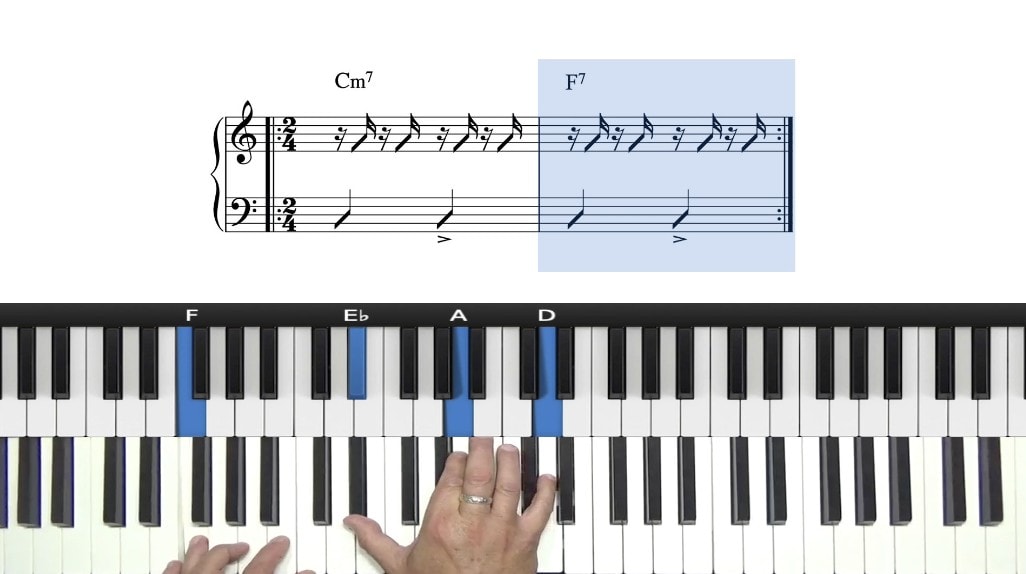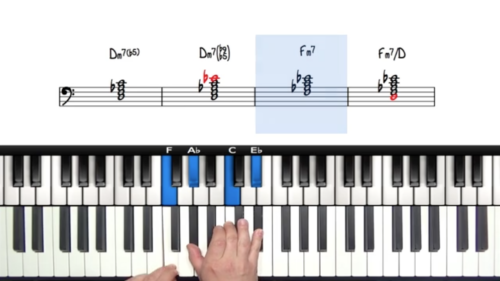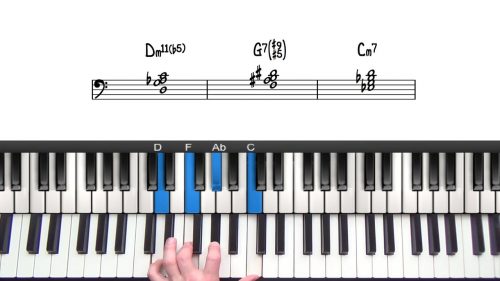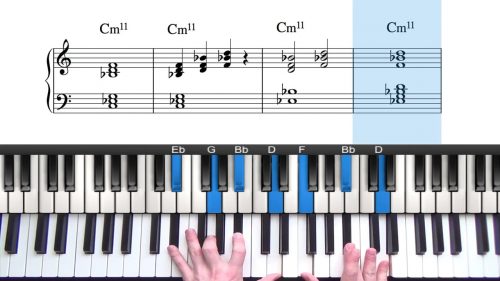Minor Grooves: Comping Patterns & Voicings
In this lesson, we will look at vamps over minor chord progressions. Similar to the major grooves lesson, we will start with simple examples and gradually build up the complexity. We will explore the minor 25, the minor 251, and some interesting circular chord progressions.
2-Bar Minor & Dominant Chord Vamps
For much of this lesson, we will focus on a simple vamp which is C-7 to F7. A minor chord going up a 4th (or down a 5th) to a dominant 7th chord is a commonly found progression in Brazilian music. The dominant chord in minor progressions usually contains extensions and alterations. These tones can be used to add interesting colours and voices to your grooves. Here’s the ‘colour tones’ that you can choose from:
- natural 13
- flat 13
- sharp 11
- sharp 9
- natural 9
- flat 9
Experiment with these different tones and the unique colours they produce.
Approach Tones In Basslines
You can use approach notes in your basslines to add additional movement and interest. This can be achieved with full step approach notes, and also half step chromatic approaches. In the lesson, we will look at combining both half and whole steps to approach the chord changes.
Chord Melodies – Make Your Chords Sing!
Choose your right-hand voicings wisely so that the top note of each voicing creates a melodic line. These lines can be complex or simple – all depending on the situation and setting.
‘Chord Melodies’ are a nice way to create counterpoint to the main melody of the song. Study the examples provided and experiment with this technique when comping through a chord progression.
Minor 251 & 1625 Progressions
We finish this study of minor grooves with the 251 and 1625 progressions. By applying these progressions over a 2-bar vamp, we will demonstrate the concepts and principles covered in the lesson.
Practice Tips
-
Experiment with the different colour tones over the V7 chord.
-
Add lyricism to your basslines with approach tones and other patterns.
-
The top note in your chord voicings can be used to create a moving melody line.
-
Practice creating simple chord melodies, and also more advanced ones as outlined in the lesson.
-
When 'making your chords sing', try to alternate ascending and descending notes, and small and big intervals.
-
This will sound a lot more musical than simply running up and down a scale.








Hey there, quick question:
I noticed that around 2:25 during the slow Samba on Cm7 and F7 sometimes also the bass note was falling on a downbeat together with the right hand. Why? Was that on purpose to emphasize the right-hand voicing?
Thanks
Luke
Hi Luke,
Thanks for getting in touch and great question.
Please check out this lesson which is a more detailed breakdown of the rhythmic aspects of the samba groove: pianogroove.com/bossa-nova-lessons/samba-pattern-for-beginners/
This is a snippet from the following seminar: pianogroove.com/live-seminars/brazilian-comping-for-beginners/ – check this seminar out too as it contains some useful practice drills and a detailed breakdown of samba piano patterns.
I believe that the right hand should avoid the downbeats when playing Samba, as you will see in the lessons and seminar referenced above.
I’m not an expert in Brazilian music, but Jovino is hosting a live seminar this Wednesday where you can ask him questions directly in the live chat, here is the seminar page where you can add it to your calendar: pianogroove.com/live-seminars/creative-harmony-seminar-part-ii/
The session is focused on triads shapes for voicings and improvisation, but Jovino will also happily answer any questions that you have on samba piano.
First take a look over the lessons above as this should help to clear things up for you and let us know if you have any further questions.
Talk soon,
Hayden